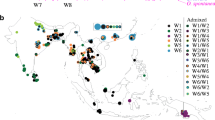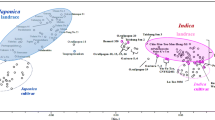Abstract
Key message
Diachronic analysis showed no significant changes in the level of genetic diversity occurred over the past 27 years’ domestication, which indicated genetic diversity was successfully maintained under on-farm conservation.
Abstract
Rice (Oryza sativa L.) is one of the earliest domesticated crop species. Its genetic diversity has been declining as a result of natural and artificial selection. In this study, we performed the first analysis of the levels and patterns of nucleotide variation in rice genomes under on-farm conservation in Yunnan during a 27-year period of domestication. We performed large-scale sequencing of 600 rice accessions with high diversity, which were collected in 1980 and 2007, using ten unlinked nuclear loci. Diachronic analysis showed no significant changes in the level of genetic diversity occurring over the past 27 years’ domestication, which indicated genetic diversity was successfully maintained under on-farm conservation. Population structure revealed that the rice landraces could be grouped into two subpopulations, namely the indica and japonica groups. Interestingly, the alternate distribution of indica and japonica rice landraces could be found in each ecological zone. The results of AMOVA showed that on-farm conservation provides opportunities for continued differentiation and variation of landraces. Therefore, dynamic conservation measures such as on-farm conservation (which is a backup, complementary strategy to ex situ conservation) should be encouraged and enhanced, especially in crop genetic diversity centers. The results of this study offered accurate insights into short-term evolutionary processes and provided a scientific basis for on-farm management practices.




Similar content being viewed by others
References
Altieri MA, Merrick LC (1987) In situ conservation of crop genetic resources maintenance of traditional farming systems. Econ Bot 41:86–96
Bellon MR, Pham JL, Jackson MT (1997) Genetic conservation: a role for rice farmers. In: Hawkes JG (ed) Plant conservation: the in situ approach. Chapman and Hall, IPGRI, London
Brown AHD (2000) The genetic structure of crop landraces and the challenge to conserve them in situ on farms. In: Brush SB (ed) Genes in the fields: on–farm conservation of crop diversity. International Plant Genetic Resources Institute (IPGRI), Rome, International Development Research Centre (IDRC), Ottawa and Lewis Publishers, Boca Raton, pp 29–48
Brush SB (1991) A farmer–based approach to conserving crop germplasm. Econ Bot 45:153–165
Brush SB, Meng E (1998) Farmers’ valuation and conservation of crop genetic resources. Genet Resour Crop Evol 45:139–150
Bandelt HJ, Forster P, Rohl A (1999) Median–joining networks for inferring intraspecific phylogenies. Mol Biol Evol 16:37–48
Brown AHD (1978) Isozymes, plant population genetics structure and genetic conservation. Theor Appl Genet 52:145–157
Caicedo AL, Williamson SH, Hernandez RD et al (2007) Genome–wide patterns of nucleotide polymorphism in domesticated rice. PLoS Genet 3:1745–1756
Chen JJ, Ding JH, Ouyang YD et al (2008) A triallelic system of S5 is a major regulator of the reproductive barrier and compatibility of indica–japonica hybrids in rice. Proc Natl Acad Sci 105:11436–11441
Dai LY, Ye CR, Xu FR et al (1999) Genetic analysis on cold tolerance characteristics of Yunnan rice landrace (Oryza sativa L.) Kunmingxiaobaigu. Chin J Rice Sci 13:73–76
Doyle JJ, Dickson EE (1987) Preservation of plant samples for DNA restriction endonuclease analysis. Taxon 36:715–722
Deu M, Sagnard F, Chantereau J et al (2010) Spatio–temporal dynamics of genetic diversity in Sorghum bicolor in Niger. Theor Appl Genet 120:1301–1313
Doi K, Izawa T, Fuse T et al (2004) Ehd1, a B–type response regulator in rice, confers short–day promotion of flowering and controls FT–like gene expression independently of Hd1. Genes Dev 18:926–936
Dong SB, Lu BR, Wang YY et al (2010) Preliminary studies on the within-varietal genetic diversity and its maintenance of traditional rice from Yunnan. J Yunnan Agric Univ 25:1–9
Evanno G, Regnaut S, Goudet J (2005) Detecting the number of clusters of individuals using the software STRUCTURE: a simulation study. Mol Ecol 14:2611–2620
Excoffier L, Smouse PE, Quattro JM (1992) Analysis of molecular variance inferred from metric distances among DNA haplotypes: application to human mitochondrial DNA restriction data. Genetics 131:479–491
Fu YX, Li WH (1993) Statistical tests of neutrality of mutations. Genetics 133:693–709
Falush D, Stephens M, Pritchard JK (2003) Inference of population structure using multilocus genotype data: linked loci and correlated allele frequencies. Genetics 164:1567–1587
Fu YB, Peterson GW, Richards KW et al (2005) Allelic reduction and genetic shift in the Canadian hard red spring wheat germplasm released from 1845 to 2004. Theor Appl Genet 110:1505–1516
Glaszmann JC (1987) Isozymes and classification of Asian rice varieties. Theor Appl Genet 74:21–30
Garris AJ, Tai TH, Coburn J et al (2005) Genetic structure and diversity in Oryza sativa L. Genetics 169:1631–1638
Gao LZ (2003) The conservation of Chinese rice biodiversity: genetic erosion, ethnobotany and prospects. Genet Resour Crop Evol 50:17–32
Hammera K, Gladisa Th, Diederichsen A (2003) In situ and on-farm management of plant genetic resources. Eur J Agron 19:509–517
Hall TA (1999) Bioedit: a user–friendly biological sequence alignment editor and analysis program for Windows 95/98/NT. Nucleic Acids Symp Ser 41:95–98
Hudson RR, Kaplan NL (1985) Statistical properties of the number of recombination events in the history of a sample of DNA sequences. Genetics 111:147–164
Holsinger KE, Weir BS (2009) Genetics in geographically structured populations: defining, estimating and interpreting F(ST). Nat Rev Genet 10:639–650
Harlan JR (1975) Crops and man. American Society of Agronomy, Madison
Londo JP, Chiang YC, Hung KH et al (2006) Phylogeography of Asian wild rice, Oryza rufipogon, reveals multiple independent domestications of cultivated rice, Oryza sativa. Proc Natl Acad Sci 103:9578–9583
Liu XZ, Zhao MF, He YQ et al (2007) Breeding and blast resistance identification of Lijiangxintuanheigu nearnisogenic pyramid lines. Acta Agron Sin 33:20–24
Li ZM, Zheng XM, Ge S (2011a) Genetic diversity and domestication history of African rice (Oryza glaberrima) as inferred from multiple gene sequences. Theor Appl Genet 123:21–31
Li YB, Fan CC, Xing YZ et al (2011b) Natural variation in GS5 plays an important role in regulating grain size and yield in rice. Nat Genet 43:1266–1269
Maxted N, Guarino L, Myer L et al (2002) Towards a methodology for on–farm conservation of plant genetic resources. Genet Resour Crop Evol 49:31–46
Mao HL, Sun SY, Yao JL et al (2010) Linking differential domain functions of the GS3 protein to natural variation of grain size in rice. Proc Natl Acad Sci 107:19579–19584
Nei M (1987) Molecular evolutionary genetics. Columbia University Press, New York
Pusadee T, Jamjod S, Chiang YC et al (2009) Genetic structure and isolation by distance in a landrace of Thai rice. Proc Natl Acad Sci 106:13880–13885
Pritchard JK, Stephens M, Donnelly P (2000) Inference of population structure using multilocus genotype data. Genetics 155:945–959
Parzies HK, Spoor W, Ennos RA (2004) Inferring seed exchange between farmers from population genetic structure of barley landrace Arabi Aswad from Northern Syria. Genet Resour Crop Evol 51:471–478
Rozas J (2009) DNA sequence polymorphism analysis using DnaSP. Methods Mol Biol 537:337–350
Second G (1982) Origin of the genetic diversity of cultivated rice (Oryza spp.): study of polymorphism scored at 40 isoezyme loci. Jpn J Genet 57:25–57
Sirabanchongkran A, Yimyam N, Boonma W et al (2004) Varietal turnover and seed exchange: implications for conservation of rice genetic diversity on-farm. Int Rice Res Notes 29(2):18–19
Shang JJ, Tao Y, Chen XW et al (2009) Identification of a new rice blast resistance gene, Pid3, by genomewide comparison of paired nucleotide-binding site–leucine-rich repeat genes and their pseudogene alleles between the two sequenced rice genomes. Genetics 182:1303–1311
Sun JC, Cao GL, Jing Ma et al (2012) Comparative genetic structure within single–origin pairs of rice (Oryza sativa L.) landraces from in situ and ex situ conservation programs in Yunnan of China using microsatellite markers. Genet Resour Crop Evol 59:1611–1623
Thompson JD, Gibson TJ, Plewniak F et al (1997) The CLUSTALX windows interface: flexible strategies for multiple sequence alignment aided by quality analysis tools. Nucleic Acids Res 25:4876–4882
Tajima F (1989) Statistical method for testing the neutral mutation hypothesis by DNA polymorphism. Genetics 123:585–595
Tsegaye B, Berg T (2007) Genetic erosion of Ethiopian tetraploid wheat landraces in Eastern Shewa, Central Ethiopia. Genet Resour Crop Evol 54:715–726
Wright SI, Gaut BS (2005) Molecular population genetics and the search for adaptive evolution in plants. Mol Biol Evol 22:506–519
Wei X, Qiao WH, Chen YT et al (2012) Domestication and geographic origin of Oryza sativa in China: insights from multilocus analysis of nucleotide variation of O. sativa and O. rufipogon. Mol Ecol 21:5073–5087
Watterson GA (1975) On the number of segregating sites in genetical models without recombination. Theor Popul Biol 7:256–276
Xu FR, Zhang EL, Dong C et al (2010a) Comparison of phenotypic traits of rice landraces, grown in two different periods in Hani’s terraced fields in Yuanyang County, Yunnan. Biodiversity Science 18:365–372
Xu FR, Tang CF, Yu TQ et al (2010b) Diversity of paddy rice varieties from Yuanyang Hani’s terraced fields in Yunnan, China. Acta Ecologica Sinica 30:3346–3357
Xu FR, Dong C, Yang WY et al (2011) Comparison of genetic diversity of rice landraces planted in two periods in Hani’s terraced fields in Yuanyang County, Yunnan province, China using microsatellite markers. Chin J Rice Sci 25:38l–386
Yan HM, Dong C, Zhang EL et al (2012) Analysis of genetic variation in rice paddy landraces across 30 years as revealed by microsatellite DNA markers. Hereditas 34:87–94
Zhou YH (1988) Regionalization of rice cropping in Yunnan. In: Min SK, Wu XZ (eds) Regionalization of rice cropping in China. Zhejiang Science, and Technology Pubublication, Hangzhou, pp 104–108
Zeng YW, Wang JJ, Yang ZY et al (2001) The diversity and sustainable devolopment of crop genetic resources in the Lancang River Valley. Genet Resour Crop Evol 48:297–306
Zhu YY, Chen HR, Fan JH et al (2003) The use of rice variety diversity for rice blast control. Sci Agric Sin 36:521–527
Zhang HL, Sun JL, Wang MX et al (2006) Genetic structure and phylogeography of rice landraces in Yunnan, China, revealed by SSR. Genome 50:72–83
Zeng YW, Zhang HL, Li ZC et al (2007) Evaluation of genetic diversity of rice landraces (Oryza sativa L.) in Yunnan, China. Breed Sci 57:91–99
Zeng YW, Shen SQ, Li ZC et al (2003) Ecogeographic and genetic diversity based on morphological characters of indigenous rice (Oryza sativa L.) in Yunnan, China. Genet Resour Crop Evol 50:567–577
Zhu QH, Zheng XM, Luo JC et al (2007) Multilocus analysis of nucleotide variation of Oryza sativa and its wild relatives: severe bottleneck during domestication of rice. Mol Biol Evol 24:875–888
Zheng XM, Ge S (2010) Ecological divergence in the presence of gene flow in two closely related Oryza species (Oryza rufipogon and O. nivara). Mol Ecol 19:2439–2454
Acknowledgments
We thank the Chinese National Germplasm Bank for providing the landrace rice seeds. This work was supported by the National Key Technology Research and Development Program of China (2013BAD01B02-2, 2013BAD01B0101-02), Science and Technology Innovation Program of CAAS, the platform of National Crop Germplasm Resources, the Project of 973 (2010CB125904-5), the Protective Program of Crop Germplasm of China (NB2013-2130135-25-01), International Cooperation Project from National Institute of Crop Science, RDA (PJ008685).
Author information
Authors and Affiliations
Corresponding author
Ethics declarations
Conflict of interest statement
None.
Additional information
Communicated by M. Thomson.
Electronic supplementary material
Below is the link to the electronic supplementary material.
122_2015_2617_MOESM1_ESM.pdf
Supplementary Fig. 1 Schematic diagrams of ten nuclear loci and locations of the regions sequenced. Exons are shown as open boxes, and exon numbers are labeled with capital roman numbers. Thin lines between open boxes refer to introns. Locations of primers for each fragment are sketched above the diagrams. (PDF 151 kb)
122_2015_2617_MOESM4_ESM.pdf
Supplementary Table 1 List of the materials sampled in the study, origin and subpopulation. Code No.: Official numbers of the accessions conserved in the Chinese National Germplasm Bank. (PDF 639 kb)
122_2015_2617_MOESM8_ESM.pdf
Supplementary Table 5 Summary of haplotype richness for rice accessions in each ecological zone from 1980 and 2007. (PDF 103 kb)
Rights and permissions
About this article
Cite this article
Cui, D., Li, J., Tang, C. et al. Diachronic analysis of genetic diversity in rice landraces under on-farm conservation in Yunnan, China. Theor Appl Genet 129, 155–168 (2016). https://doi.org/10.1007/s00122-015-2617-7
Received:
Accepted:
Published:
Issue Date:
DOI: https://doi.org/10.1007/s00122-015-2617-7




